Latest Reports
On-Going Monitoring of Activities at the Yongbyon Nuclear Site
by David Albright, Sarah Burkhard, and Allison Lach
February 13, 2018
Recent commercial satellite imagery shows that the Yongbyon 5 megawatt-electric (MWe) reactor remains operational. It is unknown if North Korea recently discharged and refueled this reactor or will do so soon. In the August 2017 International Atomic Energy Agency (IAEA) Safeguards Report on North Korea, the IAEA predicted that this reactor would be due for a refueling in approximately December 2017.1 After the spent fuel is discharged, it is typically cooled for several weeks to a couple of months and then chemically processed to separate out plutonium for North Korea’s nuclear weapons. There were no major signs of any plutonium separation related activities at the Radiochemical Laboratory in recent imagery. Because North Korea may be on the verge of expanding its stock of plutonium for nuclear weapons, the reactor and associated Radiochemical Laboratory deserve greater scrutiny. Despite construction over many years, the 100 megawatt-thermal (MWth) Experimental Light Water Reactor (ELWR) seems non-operational. However, commencement of operation could occur soon. The Institute also received procurement information related to a potential ELWR fuel fabrication facility near the abandoned 50 MWe reactor. Yet, more information is needed. The original Fuel Fabrication Complex in the southern part of the site underwent some light construction progress. This complex includes a suspect Isotope Separation Facility that can, when operational, separate tritium for boosted and thermonuclear weapons. The nearby centrifuge plant, which is likely one of two or more centrifuge plants in North Korea, appears to be operational. Achieving a nationwide freeze to North Korea’s production of plutonium, enriched uranium, and thermonuclear materials remains a reasonable, albeit difficult to achieve goal.
5 MWe Reactor
North Korea’s 5 MWe reactor at the Yongbyon nuclear center remains operational, producing plutonium for nuclear weapons. In a Digital Globe image dated January 17, 2018, steam is visible coming from the reactor’s turbine building, and hot water appears to be melting snow at the discharge pipe for this reactor (see figure 1). Steam emission suggests that the reactor is producing electricity. The water discharge is most likely from a secondary cooling system used to cool the carbon dioxide gas from the 5 MWe reactor core. The Institute assesses that the 5 MWe reactor’s secondary cooling system may be receiving water through a very long piping system connected to a water intake building 1.5 kilometers (km) north of the reactor.2
In a January 30, 2018 Airbus image, no steam is visible but hot water may be coming from the discharge pipe (see figure 2).
Figure 3 is a Google Earth image from August 21, 2016 which shows what the reactor site and the river look like during warm summer months.
The reactor appears to have operated intermittently during 2017, but it has been producing plutonium. According to the IAEA’s August 2017 Safeguards Report on North Korea, the IAEA estimated that, if the reactor fueling cycle remains similar to previous cycles, North Korea would unload the fuel in the reactor core in approximately December 2017. After cooling for several weeks or a couple of months, the irradiated fuel would be sent to the Radiochemical Laboratory for chemical processing to extract the plutonium for use in nuclear weapons.
Given that the reactor was in operation in mid-January 2018, the core reloading may have occurred, and the reactor may have been restarted. The 2016 IAEA Safeguards Report on North Korea indicates that, previously, between cycles, the reactor was non-operational for several weeks (mid-October 2015 to early December 2015) which the IAEA described as “sufficient for the reactor to have been de-fueled and subsequently re-fueled.”3 However, the core unloading may not yet have occurred. Because of this uncertainty, the reactor and associated Radiochemical Laboratory deserve greater scrutiny (see below for more information on activities at the Radiochemical Laboratory).
Radiochemical Laboratory
Little activity is visible at the Radiochemical Laboratory site where North Korea chemically processes irradiated fuel from the 5 MWE reactor, separating plutonium for nuclear weapons, and processing the resulting nuclear waste; however, the long main building, where plutonium is separated from the fuel, may be heated. Mid-January was very cold in North Korea. The weather service in Pyongyang reported temperatures mostly in the teens (Fahrenheit).4
Therefore, it is significant that despite the lack of other visible signs of major activity, the January 17, 2018 Digital Globe image shows almost no snow on the roof of the long plutonium separation building and a few workshop buildings (see figure 4), which implies that these buildings may be heated and are thus in use. Other roofs are at least half-covered by snow. The workshops show some activity outside of their entrances, indicated by melted snow and traces of snow. Previously empty and open, possible waste tanks in the south of the plant are covered. The January 30, 2018 Airbus image shows that many roofs are still partially covered by snow, while the long reprocessing building, spent fuel reception area, chemical storage, and workshops appear snow-free (see figure 5). Figure 6 provides comprehensive annotation of the site. No tanks or casks similar to those in the May 2016 Digital Globe image are visible in the two January images.
Coal Fired Steam Generation Plant
The coal fired steam plant to the south-east of the Radiochemical Laboratory generates steam used in several activities at the Radiochemical Laboratory. For example, the steam provides heat for nuclear waste minimization and solidification. As such, activity at the steam plant would be a major indicator for reprocessing activities. Neither of the recent images acquired by the Institute show concrete signs of activity (such as exhaust plumes). The coal stockpiles are covered in snow; however, the images show no snow on the roof of the reception building, and on top of the coal conveyors (see figures 7 and 8). Vehicle tracks visible in the snow can be traced to the reception building. The pipe that transfers the steam from the coal plant to the Radiochemical Laboratory also seems free of snow.
Experimental Light Water Reactor (ELWR)
After a several year delay, North Korea appears determined to finish the 100 megawatt-thermal (or about 30 MWe)5 Experimental Light Water Reactor adjacent to the 5 MWe reactor.6 According to North Korean statements made in 2010, the reactor was originally slated for operation in 2012, but in 2011, North Korean officials said operation was delayed until 2013.7 North Korea appeared to slow reactor construction further as it retrofitted the 5 MWe reactor and expanded the centrifuge plant at Yongbyon during 2013-2015. However, in the last few years, which is a time when the North Korean government has made broad efforts to expand its nuclear capabilities, Pyongyang appears to be finishing the reactor.
Yet, it is difficult to know when it could start. Some analysts believe the reactor has undergone testing of its secondary cooling system and other preparations.8 Others are not so sure. Moreover, the two recent commercial satellite images do not have visible signatures suggesting operation during January 2018 (see figures 9 and 10).
According to government sources, North Korea has been bringing goods into the reactor building although their exact purpose is not known. For example, it is known that North Korea obtained a Japanese-manufactured fuel rod drive suitable for this reactor about two or three years ago. Nonetheless, the exact status of the installation and testing of reactor components and equipment inside the building remains uncertain.
Perhaps, the best indicator of startup will be high resolution thermal imagery of the ELWR’s core. Several governments can take high resolution thermal imagery that could detect the start of core operations. It is possible that Landsat thermal imagery, which has a far poorer resolution than intelligence community satellites, will be able to detect heat in the core, although since the reactor has a thick concrete reactor dome, this determination may be more difficult than detecting heat from the 5 MWe reactor, which has a core contained in a thinskinned industrial structure.
As confirmed by the IAEA Safeguards Report in 2016, the construction of an electrical switchyard took place adjacent to the ELWR.9 According to an article published by Jane’s Intelligence Review, the power substations next to the ELWR were added between March and April 2017 and an electrical line was visible as of mid-September 2017.10 The electrical switchyard and the transmission lines can be seen in both of the recent January 2018 images (figures 9 and 10) due to the presence of snow on the cables. The Jane’s authors suggest the lines connect the ELWR to a local electrical grid via a transmission tower on the opposite side of the river so as to be used in part as an electrical power generator.
Over the summer of 2017, the Jane’s article noted much activity that suggested renovations inside the ELWR were taking place, including the presence of a crane that could have been used to transfer critical components and equipment into the building. By October 2017, all such activity around the ELWR had stopped, according to the article. As noted above, the operational readiness of the equipment and components inside the reactor hall is unknown.
Questions also publicly surround the reactor’s secondary cooling system, which uses cold water from the adjacent river and likely discharges heated water back into the river. Most notably, according to the September 2017 UN Panel of Experts report on North Korea, a member state reportedly observed hot water being “discharged through the drainage channel of the light water reactor.”11 This reportedly indicated that the secondary cooling system was undergoing testing at that time. Unfortunately, no information is made available in the report on where the discharge allegedly took place or the source of the heat. Determining the intakes and outtakes of this cooling system has been difficult.
In addition, questions remain about where and how the water intake for the secondary cooling system operates. According to Jane’s, construction on two channels began in 2013 and was completed in November 2017. According to Jane’s, the channels would funnel water into a cistern, which would reportedly be the key intake for cold water into the ELWR’s secondary cooling system. This argument needs more support as there are several cisterns and man-made channels along the river, suggesting that the cistern-channel system could have non-nuclearrelated purposes.
The article states that construction equipment was visible throughout 2017 to build an embankment between the cold water intake it identifies and the ELWR hot water discharge, which potentially occurs just downstream from the suspected intake cistern. The authors suggest also that hot water discharged by the 5 MWe reactor upstream melts frozen river water in the winter as it flows downstream to the ELWR, thereby supplying the ELWR with a useable supply of water for its secondary cooling system in the winter. The January 17, 2018 Digital Globe image potentially supports this claim. The alleged ELWR cooling-water intake channels seem less frozen than in the January 30, 2018 Airbus image (figures 9 and 10). As seen in figure 1, the 5 MWe reactor appeared to be operating on January 17, 2018. However, the use of this arrangement, dependent on an aged reactor, raises questions.
Other observations in the Jane’s report include dredging and construction equipment in the spring of 2016, and the implementation of a weir, presumably to control water flow during monsoon season or flooding. In addition, Jane’s points out a potential “hot water discharge line” right below what looks like a dam extending the weir across the river. Here, it is unclear whether the pipes laid in 2011, visible in 2011 imagery (figures 11a and 11b) are being discussed. As can be seen in the images, the pipes run parallel to the new “dam” but do not seem to extend all the way across the river. Rather, the pipe runs about two-thirds into the river. Furthermore, the pipe seems to be so close to the cistern that it would be north of the “dam” rather than south of it, as labeled by Jane’s. However, in the images published by Jane’s, snow seems to be absent along the line, and some ice seems melted where the pipe could approximately end.
Other secondary cooling system possibilities for the ELWR include piping laid in 2012 and 2013. The trenches seen in figure 11c seem to lead to a building near the river. Some people call this the ELWR pump house,12 but it seems to be quite far from the river with no clear and visible connection to it. The river water level also seems to fluctuate considerably during the year, which would make the pump house potentially unreliable. The trenches seen in figure 11d lead to the river, and several people have proposed this to be a potential discharge channel for hot water from the ELWR’s secondary cooling system.13
The uncertainty in this analysis shows that more information is needed to determine the water intake and discharge paths for the secondary cooling pathways. However, determining in particular the hot water discharge paths and outfalls could provide another way to come to conclusions about whether the ELWR is operating.
Whatever the cooling arrangements, if the ELWR does operate, it represents a potentially significant step forward for the North Koreans who have desired to have a larger reactor for several decades and a much large plutonium stockpile. Because this reactor can be operated to make weapon-grade plutonium, the operation of the ELWR could add significantly to the regime’s stock of plutonium for nuclear weapons. Once operating at full capacity, the ELWR would be able to produce 25 - 30 MWe of electricity,14 as well as plutonium and tritium for nuclear weapons. Each year, operating at full power, it could produce about 20 kilograms of weapon-grade plutonium, or over four times the amount of weapon-grade plutonium made annually in the 5 MWe reactor.15
Light Water Reactor (LWR) Fuel Fabrication Facilities
The light water reactor needs a different type of fuel than the 5 MWe reactor, which uses a natural uranium metal fuel that in the past was fabricated in a series of buildings in the Fuel Fabrication Complex. The ELWR apparently needs a fuel that involves low enriched uranium dioxide formed into pellets and then inserted into fuel cladding. There are few details about where at Yongbyon North Korea makes LWR fuel. There have been suggestions that two facilities north of the 5 MWe reactor are possible candidates for fabricating LWR fuel.16
New information from a government that closely tracks North Korean procurement suggests another building, located near the defunct 50 MWe reactor, is involved in LWR fuel fabrication. According to this source, the information pointing to the site is based on the known delivery to this building of North Korean procurements purchased abroad of an entire line to make sintered LEU pellets. It is possible that the equipment was delivered to this address and subsequently moved to another nearby facility. However, the building itself seems adequate to hold a pellet production line. We have no information on where North Korea would assemble the pellets into fuel rods, create the fuel cladding, or manufacture the finished rods into fuel assemblies.
Figures 12 through 15 show the building during and after construction, which started in 2011, a logical time period in which to construct this building based on the then-expected startup date of 2013 (see above). The internal structure of the building includes several rooms, which could be used to conduct the various aspects of making fuel pellets.
About four or five years ago, according to the government source, the North Korean government created a purchase list for a small fuel pellet production line that included a sintering furnace, pelleting equipment, inspection equipment, and ultrasonic cleaning equipment. North Korean agents approached a range of suppliers in China to buy equipment on its shopping list. They successfully obtained the goods to build the line mostly in China. Other than learning that the ultrasonic equipment came from a Japanese supplier, which was unlikely to know the true purpose of this sale, the Institute did not learn of the specific origin of the equipment. In general, the equipment is typically not found on Nuclear Supplier Group dual-use lists, but catch-all controls and UN Security Council sanctions would have prohibited the sale of this equipment to North Korea. The delivery of at least some of this equipment to this building was observed by a government.
It should be noted, however, that the Institute was not able to confirm that this building makes fuel pellets. It is continuing to investigate North Korean LWR fuel manufacturing capabilities.
Fuel Fabrication Complex and Centrifuge Building
At the Fuel Fabrication Complex in the southern part of the site, the January 17, 2018 Digital Globe image in particular shows that the majority of roofs are covered by snow (figure 16). An exception is the main centrifuge building, where the snow has almost completely melted. If the centrifuges are operating, as believed, they are kept at a near constant temperature well above freezing, which would account for the snow melt. (A temperature of 20° C is reasonable.)
The January 30, 2018 Airbus images shows that, with exception of a few buildings, more roofs are free of snow. Possible excavation is visible in the south of the facility (figure 17).
Possible Isotope Separation Facility
Already present in the January 17, 2018 image, but pointed out in the January 30, 2018 Airbus image, is a completed roof of a small building near the main building of the possible Isotope Separation Facility that, when operational, could separate tritium for boosted or thermonuclear nuclear weapons (see figures 18 and 19). What initially looked like the construction of one building was later divided into two smaller buildings with a path in between them (see figure 20). The January 17, 2018 Digital Globe image shows that the rail tracks leading to the plant are covered in snow. Some construction material seems yet to be cleared, and uncovered dirt and traces in the snow indicate other minor activity around the plant.
It could not be determined if the suspect Isotope Separation Facility is operational, although the overall signatures at the site do not suggest operation.
1. Report by the International Atomic Energy Agency Director General, Application of Safeguards in the Democratic People’s Republic of Korea, GOV/2017/36-GC(61)/21, August 25, 2017, http://isis-online.org/uploads/iaeareports/documents/IAEA_Report_North_Korea_Aug2017.pdf ↩
2. David Albright and Serena Kelleher-Vergantini, “Monitoring Activity at Yongbyon Nuclear Site” (Washington, D.C.: Institute for Science and International Security, April 23, 2014), http://isis-online.org/isis-reports/detail/monitoring-activity-at-yongbyon-nuclear-site/10↩
3. IAEA Director General, Application of Safeguards in the Democratic People’s Republic of Korea, GOV/2016/45-GC(60)/16, August 19, 2016, https://www.iaea.org/About/Policy/GC/GC60/GC60Documents/English/gc60-16_en.pdf↩
4. “Past Weather in Pyongyang, North Korea — January 2018,” Time and Date, https://www.timeanddate.com/weather/north-korea/pyongyang/historic?month=1&year=2018↩
5. Siegfried S. Hecker, “A Return Trip to North Korea’s Yongbyon Nuclear Complex” (Stanford University, Center for International Security and Cooperation, November 20, 2010), http://iisdb.stanford.edu/pubs/23035/HeckerYongbyon.pdf↩
6. See for example, Allison Puccioni and Elliot Serbin, “North Korean ELWR makes progress towards Operations,” Jane’s Intelligence Review, January 3, 2018, http://www.janes.com/images/assets/853/76853/North_Korean_ELWR_makes_progress_towards_operations.pdf↩
7. Hecker, “A Return Trip” ; Interview with North Korean official Ri Hong Sop by David Albright in Pyongyang, December 2018.↩
8. Puccioni and Serbin, “North Korean ELWR makes progress towards Operations.”↩
9. Application of Safeguards in the Democratic People’s Republic of Korea, August 25, 2017.↩
10. Puccioni and Serbin, “North Korean ELWR makes progress towards Operations.”↩
11.Midterm report of the Panel of Experts submitted pursuant to resolution 2345 (2017), September 5, 2017. All reports can be found on the website of the United Nations Security Council Subsidiary Organs, 1718 Sanctions Committee (DPRK), Panel of Experts reports: https://www.un.org/sc/suborg/en/sanctions/1718/panel_experts/reports↩
12.See for example, Chaim Braun, Siegfried Hecker, Chris Lawrence, and Panos Papadiamantis, “North Korean Nuclear Facilities After the Agreed Framework” (Stanford University, Center for International Security and Cooperation, May 27, 2016); William Mugford, “North Korea’s Yongbyon Nuclear Facility: Slow Progress at the Experimental Light Water Reactor” (Washington D.C.: 38North, January 14, 2016).↩
13.See for example, Braun et al, “North Korean Nuclear Facilities After the Agreed Framework.”↩
14.Hecker, “A Return Trip to North Korea’s Yongbyon Nuclear Complex.”↩
15.The Institute did not perform detailed calculations but a rough estimate was conducted with the support of a reactor expert. The resulting estimate is 19.5-22.3 kg weapon-grade plutonium per year. See footnote 17 in David Albright, North Korean Plutonium and Weapon-Grade Uranium Inventories (Washington, D.C.: Institute for Science and International Security, January 2015, revised October 2015), https://isis-online.org/uploads/isis-reports/documents/North_Korean_Fissile_Material_Stocks_Jan_30_2015_revised_Oct_5_2015-Final.pdf↩
16.Paul Brannan, “Additional Construction Activity at Yongbyon Nuclear Site” (Washington, D.C.: Institute for Science and International Security, June 2011); Nick Hansen, “Major Development: Reactor Fuel Fabrication Facilities Identified at Yongbyon Nuclear Complex” (Washington D.C.: 38North, December 2013).↩
Images
Figure 1. A January 17, 2018 Digital Globe image showing the Yongbyon 5 MWe reactor, with steam visible from the reactor’s turbine building, implying the reactor is operational.
Figure 2. A January 30, 2018 Airbus image showing the Yongbyon 5 MWe Reactor.
Figure 3. An August 21, 2016 Google Earth image showing the 5 MWe Reactor and the ELWR during summer months.
Figure 4. A January 17, 2018 Digital Globe image showing the Radiochemical Laboratory at the Yongbyon nuclear site.
Figure 5. A January 30, 2018 Airbus image showing the Radiochemical Laboratory at the Yongbyon nuclear site.
Figure 6. A May 22, 2016 Digital Globe image with full annotation of the Radiochemical Laboratory at the Yongbyon nuclear site.
Figure 7. A January 17, 2018 Digital Globe image showing the Coal Fired Thermal Plant at the Yongbyon nuclear site.
Figure 8. A January 30, 2018 Airbus image showing the Coal Fired Thermal Plant at the Yongbyon nuclear site.
Figure 9. A January 17, 2018 Digital Globe image showing developments at the Experimental Light Water Reactor at the Yongbyon nuclear site.
Figure 10. A January 30, 2018 Airbus image showing developments at the Experimental Light Water Reactor at the Yongbyon nuclear site.
Figure 11a. Google Earth Image of the ELWR during construction. May 27, 2011.
Figure 11b. Google Earth Image of the ELWR during construction. September 2, 2011.
Figure 11c. Google Earth Image of the ELWR during construction. October 2, 2012.
Figure 11d. Google Earth Image of the ELWR during construction. March 28, 2013.
Figure 12. Google Earth imagery from 2011 and 2014 showing the suspect ELWR fuel fabrication plant during and after construction.
Figure 13. A September 21, 2012 Google Earth image showing the suspect fuel fabrication plant near the abandoned 50 MWe Reactor at the Yongbyon nuclear site.
Figure 14. A January 17, 2018 Digital Globe image showing the suspect fuel fabrication plant near the abandoned 50 MWe Reactor at the Yongbyon nuclear site.
Figure 15. A January 30, 2018 Airbus image showing the suspect fuel fabrication plant at the Yongbyon nuclear site.
Figure 16. A January 17, 2018 Digital Globe image showing the original Fuel Fabrication Complex in the south-east of the Yongbyon nuclear site.
Figure 17. A January 30, 2018 Airbus image showing the original Fuel Fabrication Complex in the southeast of the Yongbyon nuclear site.
Figure 18. A January 17, 2018 Digital Globe image showing the Possible Isotope Separation Facility at the Yongbyon nuclear site
Figure 19. A January 30, 2018 Airbus image showing the Possible Isotope Separation Facility at the Yongbyon nuclear site and a nearby, possibly associated building where a roof has been added
Figure 20. An August 21, 2016 Google Earth image showing the building discussed in figure 19 near the Possible Isotope Separation Facility before the roof was added.
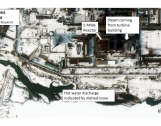
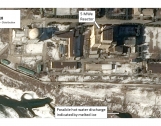

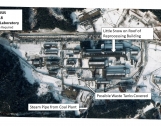
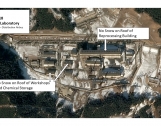
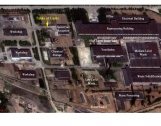

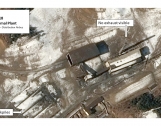
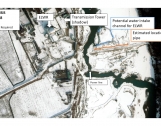
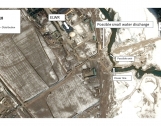
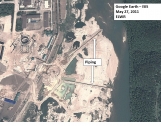
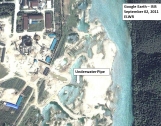
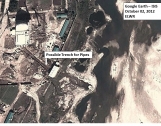
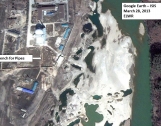

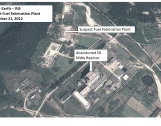
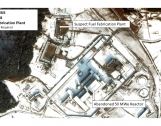

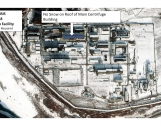
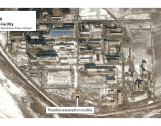
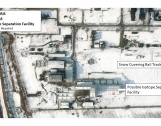
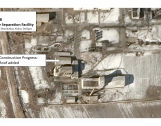

 twitter
twitter




